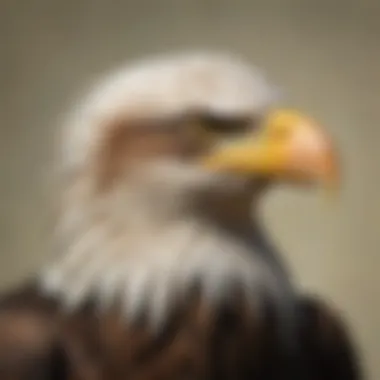Exploring the Bald Eagle as America's National Bird


Intro
The bald eagle occupies a celebrated position in the tapestry of American identity. The grandeur of this majestic bird, gliding effortlessly through the skies, has earned it a prominent spot in the hearts and minds of many. For years, it has been synonymous with strength, freedom, and resilience, embodying the spirit of a nation.
To dive into the depths of what makes the bald eagle the national bird, one must consider not just its striking appearance or its place in the ecosystem, but also the rich historical context that led to its selection. The journey of understanding this symbol is as intricate as the strands of its feathers.
In the following sections, we will embark on a multifaceted exploration, peeling back the layers of significance attached to the bald eagle. From historical roots to cultural representations, each aspect contributes to a deeper understanding of its revered status in the United States.
Historical Context of the Bald Eagle in America
The bald eagle has long been a prominent figure in the historical panorama of the United States. Its selection as a national symbol wasn't just a whim but arose from a rich tapestry of meaning intertwined with the ideals and aspirations of the nation. In this section, we will explore how the bald eagle earned its esteemed status through early recognition, adoption as a national symbol, and the legislative processes that cemented its place in American culture.
Early Recognition of the Species
Before it became the icon we recognize today, the bald eagle was acknowledged in American culture as a creature of great significance. Explorers and settlers in the 17th and 18th centuries often marveled at its impressive wingspan and distinctive white head. This bird, known scientifically as Haliaeetus leucocephalus, got its name because of its striking appearance—its feathered crown resembling a bald head, a descriptor that might raise eyebrows today, but historically reflected a lionization of baldness as often associated with wisdom and seriousness.
"The bald eagle, a master of the skies, captured imaginations long before it was chosen to represent a nation."
Early American colonists frequently encountered bald eagles in their natural habitats, where they nested along the banks of rivers and coastlines. To them, the bird symbolized strength and endurance, traits that resonated with the emerging identity of a new nation.
Adoption as National Symbol
The adoption of the bald eagle as a national symbol was deeply rooted in the American revolutionary experience. In the wake of independence, Founding Fathers like Benjamin Franklin and Thomas Jefferson debated various emblems to represent the nation. However, the bald eagle won out in 1782 when it was officially adopted as the national bird of the United States, finding a home on the Great Seal.
Its selection was not without contention. Franklin himself famously preferred the turkey, arguing that it was a more respectable bird. Yet, the bald eagle's association with power and freedom struck a chord.
This symbol was not just reflective but also aspirational; it represented the ideals of liberty and courage, differentiating a new American identity needing a potent emblem. The eagle soaring high in the sky has become synonymous with American pride, a testament to the triumph over adversity.
Legislative Endorsement
The bald eagle's path to becoming a symbol was aided not only by public sentiment but also by legislative measures. In 1782, Congress officially adopted the bald eagle for the Great Seal. This legislative endorsement was more than a formality; it was a crucial recognition of the bird's significance to the American ethos.
Following this, various laws and acts were put in place to protect the bald eagle, culminating in the Bald Eagle Protection Act of 1940. This act provided a framework for the conservation of the species, emphasizing its importance not just as a national symbol but as a vital part of the American ecological landscape.
The existence of such protective legislation reflects a broader acknowledgment of the bald eagle's role, not just as a mascot but as a living embodiment of the values that Americans hold dear.
In summary, the bald eagle's historical context is a story of recognition, reverence, and protection. Its journey from a mere species to the emblem of American ideals illustrates the complexities of national identity and the importance of symbols in shaping cultural narratives.
Symbolism of the Bald Eagle
The bald eagle is more than just a bird; it has become a powerful symbol representing freedom and independence in the United States. To understand its significance, one must consider various aspects of its portrayal in American culture, how it appears in official symbols, and its overall role in the iconographic landscape of the nation. Symbolism shapes identities, and in the case of the bald eagle, it reflects the values and ideals that Americans hold dear.
Emblem of Freedom and Independence
The bald eagle, with its majestic wings and sharp gaze, represents the very essence of freedom and independence. When the Founding Fathers decided to adopt the bald eagle as the national bird, they sought a powerful symbol that showcased the country's aspirations. This bird, soaring high above the landscape, is often seen as an embodiment of liberty, standing tall against oppression.
When observers look up at a bald eagle in flight, they can’t help but feel a sense of pride about their nation. This notion is no accident; it was carefully chosen to inspire citizens to appreciate their hard-won freedoms. People often regard the eagle as a reminder that they, too, are capable of soaring high and achieving their dreams.
"The bald eagle soars not just for itself but for every American who dares to dream big."
Representation in National Seals and Flags
The bald eagle occupies a central place in many national symbols. It appears prominently on the Great Seal of the United States, where it clutches a bundle of arrows — representing war — and an olive branch — symbolizing peace. This duality highlights America's commitment to both peace and the readiness to defend itself when necessary. It's a reflection of the nation's belief in striving for peace while remaining vigilant.
Additionally, several state flags and seals incorporate the bald eagle, further cementing its status as a national emblem. The use of the eagle in visual representation serves to connect citizens with their heritage, reminding them of the country's founding principles and the journey toward independence.
Role in American Iconography


The role of the bald eagle in American iconography goes beyond just political symbolism. In various artworks, advertisements, and literature, it symbolizes strength, resilience, and freedom. Its image invokes emotions, ranging from patriotism to motivational zeal. For instance, during national holidays like the Fourth of July, the presence of eagles in fireworks displays or parades reinforces the essence of what it means to be American.
Moreover, the bald eagle’s representation in educational materials plays a critical part in instilling patriotic pride among younger generations. Children learn about this majestic bird not only as a species but as an emblem that carries rich historical narratives and cultural significance.
Ecological Significance of the Bald Eagle
The bald eagle is not just an icon of American identity; it holds immense ecological significance as well. This majestic bird plays a critical role in maintaining the health of various ecosystems. By focusing on its habitat, diet, and overall influence on the environment, we get a fuller picture of why the bald eagle deserves our attention, particularly in conservation discussions.
Habitat and Nesting Patterns
Bald eagles typically build their nests near large bodies of water, which are essential for their hunting habits. They prefer tall trees, such as pines, oaks, and cottonwoods where they can effectively spot prey below. The size and structure of their nests are impressive; they can grow to be several feet wide and may weigh over a ton.
Interestingly, bald eagles often return to the same nest year after year, adding new materials each season. This habit can lead to remarkably large nests that signify the bird's long-term use of a particular site. While they are found all over North America, their nesting habits may slightly shift based on regional climates and availability of resources.
"Nesting habits of bald eagles highlight their connection to their habitat, emphasizing the need for preserving these essential environmental spaces."
Diet and Hunting Behavior
As apex predators, bald eagles primarily feed on fish, which makes up a significant portion of their diet. They are skilled hunters, utilizing their excellent vision to spot fish from considerable heights before diving down with remarkable speed. But they also have a varied diet that includes small mammals, birds, and carrion. Observing a bald eagle in action is nothing short of awe-inspiring; watching them soar, then suddenly plummet toward their prey is a vivid reminder of nature's raw power.
Moreover, their feeding habits contribute to the health of local ecosystems. By preying on weak or sick fish and animals, they help maintain the balance within the food web. This interaction further cements their role as a cornerstone species, reinforcing their status among top-level predators.
Influence on Ecosystem Health
The bald eagle’s presence in an area often serves as an indicator of ecosystem health. When these birds thrive, it suggests a balanced habitat supporting diverse wildlife populations. Conversely, a decline in bald eagle numbers can signal environmental distress, attributed to issues such as pollution, habitat destruction, or food scarcity.
By safeguarding the bald eagle’s populations, we are inadvertently protecting their ecosystems. This has led to public interest and conservation behaviors focusing not just on the eagle itself but on its critical environment, drawing attention to the importance of maintaining clean water sources and abundant forests.
Cultural Representations of the Bald Eagle
The bald eagle's representation in American culture is both profound and multifaceted. It encapsulates not just the spirit of freedom and power but serves as a bridge connecting various threads of social identity, historical legacy, and artistic expression within the United States. Beyond its role as a national symbol, the bald eagle's impact resonates throughout art, literature, and even indigenous traditions, showcasing its importance in the collective consciousness of the nation.
Depictions in Art and Literature
The bald eagle has made its mark across different art forms, revealing the enduring fascination that many artists have with this majestic bird. From classic paintings to modern illustrations, the eagle's image often embodies strength, liberty, and beauty. Renowned artists like John James Audubon devoted much of their work to portraying North American wildlife, with the bald eagle as a central figure. In literature, the bird often symbolizes noble ideals, courage, and resolve, often used in stories to inspire and unite.
- Examples:
- In The Last of the Mohicans by James Fenimore Cooper, the eagle represents the untamed spirit of America.
- The eagle features prominently in the artwork of American nationalism, from coins to murals, conveying a sense of pride and heritage.
The way the bald eagle is depicted in these creative works not only preserves its significance but also ensures that future generations recognize its importance in shaping American identity.
Influence on Native American Traditions
Long before it became a national symbol, the bald eagle held substantial significance in the cultures of Native American tribes. Various tribes consider the eagle a sacred creature, a messenger between the earth and the heavens. The feathers of the bald eagle are particularly revered, often used in spiritual rituals and ceremonies. These feathers symbolize honor and courage and are a mark of achievement.
- Key Points:
- The eagle is often associated with spiritual guidance and protection in Native American traditions.
- Different tribes have their unique interpretations of the eagle's symbolism, enriching the narrative of this bird in cultural history.
Through storytelling, songs, and dance, the influence of the bald eagle is firmly entrenched in Native American heritage—a testament to its deep-rooted symbolism across generations.
Use in Heraldry and Nationalism
Heraldry often channels the essence of identity and power, and the bald eagle has prominently found its place in this realm. In the U.S. coat of arms, the eagle is depicted as a robust figure, clutching arrows and an olive branch, signifying the balance between war and peace. This imagery represents the nation's resilience and aspirations.
- Prominent Heraldic Features:


- The eagle has been utilized in military insignia, embodying the strength and honor of armed forces.
- Its presence in government seals and official emblems reinforces the eagle’s role as a cornerstone of American authority.
In essence, the bald eagle serves as a potent emblem of nationalism, resonating with those who recognize it as representing their values, heritage, and the democratic ideals of the United States.
"The eagle from Washington’s time to modern day has been a constant presence in America’s narrative, weaving through various aspects of culture and identity."
By exploring these dimensions of cultural representation, we can appreciate the bald eagle not merely as a bird, but as an integral part of a larger tapestry that illustrates America’s story.
Conservation of the Bald Eagle
The conservation of the bald eagle is crucial not only for its survival but also for the overall health of the ecosystems it inhabits. By learning about the initiatives aimed at protecting this magnificent bird, one can understand how deeply interconnected wildlife preservation is with our environmental policies and practices. The bald eagle serves as a symbol of American strength and resilience, making its conservation efforts all the more significant. In tackling the challenges it faces, we preserve not only a national emblem but also ensure the viability of ecosystems across North America.
Endangered Species Act Impact
The Endangered Species Act, enacted in 1973, has played a pivotal role in the conservation of the bald eagle. Prior to the act's introduction, bald eagle populations were dwindling at alarming rates due to habitat destruction, hunting, and the effects of pesticides like DDT. Once listed as endangered, the bald eagle gained federal protection, allowing for recovery efforts to be initiated. Significant changes in legislation and conservation tactics provided the necessary support to revive the population.
The impact of this act is evident in various ways. For instance, the establishment of protective zones around nesting sites has helped secure vital habitats. Additionally, there have been concerted efforts to eliminate harmful substances in the environment. Thanks to such measures, the bald eagle's status was upgraded to threatened in 1995 and eventually to delisted in 2007, showcasing a tremendous recovery journey.
Recovery Efforts and Success Stories
The bald eagle's journey back from the brink of extinction is nothing short of remarkable. Various organizations, state agencies, and dedicated individuals have worked hand in hand to implement recovery strategies that proved effective. Here are some key efforts and success stories:
- Habitat Restoration: Protecting and restoring wetlands and waterways have been vital, as these are crucial for nesting.
- Public Awareness Campaigns: Educative programs that target schools and communities have made people more aware of the eagle's plight, leading to more public support for conservation initiatives.
- Monitor Programs: Organizations such as the U.S. Fish and Wildlife Service frequently conduct surveys to monitor population numbers and nesting success rates.
The resurgence of the bal eagle populations in places like the Chesapeake Bay serves as a testament to the effectiveness of these efforts. In the early 20th century, their numbers had dramatically fallen, but recent counts indicate thousands of nesting pairs exist today in the area, demonstrating that concerted conservation actions can yield positive results.
Current Threats and Challenges
Despite an encouraging recovery, the bald eagle still faces numerous threats that impact its long-term survival. It’s important to remain vigilant about these challenges to ensure they do not jeopardize the hard-won gains achieved over the years. Here’s what they face today:
- Habitat Loss: Urban development and industrial growth continue to encroach on essential habitats, resulting in the loss of crucial nesting and feeding areas.
- Pollution: Toxic substances, including lead from bullets and pesticides, threaten the health of bald eagles, leading to decreased reproductive success.
- Climate Change: Alterations in climate patterns affect food availability and nesting sites, creating further pressures on eagle populations.
- Human Disturbance: Activities such as boat traffic and recreational use of nesting areas inadvertently disrupt breeding cycles, stressing the birds.
"Protecting the bald eagle isn't just about saving a bird; it's about maintaining the balance of our ecosystems and preserving the natural heritage of the United States."
Understanding these factors is essential for ongoing efforts to safeguard the bald eagle and its habitat. By remaining informed, we can all contribute to the fight against these challenges, ensuring that the symbol of independence continues to soar high above the land.
Common Misconceptions about the Bald Eagle
The bald eagle, while an iconic symbol of the United States, is often surrounded by myths and misunderstandings. It’s not just the majestic presence of this bird that captivates; it’s also the stories and inaccuracies that bond its image to the American narrative. This section seeks to disentangle these misconceptions to foster a more accurate portrayal of the bald eagle and its environment. Understanding these misconceptions is crucial for education and conservation efforts, as well as for appreciating this magnificent bird in its true light.
Distinction from Other Birds of Prey
One of the more frequent mix-ups is identifying the bald eagle with other birds of prey, such as the golden eagle or various hawks. While all these birds share a certain majesty, each has distinct characteristics that set them apart. The bald eagle, notable for its signature white head and tail, contrasts sharply with darker-feathered raptors. Also, its size gives it a commanding presence; adult bald eagles can weigh between three to six and a half kilograms and have wingspans that can reach up to seven feet.
Beyond appearance, their hunting techniques and habitats differ: bald eagles primarily feast on fish, swooping down to snatch them from water bodies, while other raptors may hunt a wider array of prey like small mammals or smaller birds. Understanding these differences helps appreciate the bald eagle's unique ecological role.
Misunderstandings Related to Behavior
Behavioral traits of the bald eagle often spur speculation and misunderstandings. Many assume they are aggressive and relentless predators, but their hunting methods are actually quite strategic. They rely on keen eyesight to spot prey from a distance and prefer to hunt in cooperation rather than competition.
Additionally, eagles have a reputation for a solitary lifestyle. However, during breeding season, they tend to be more social. They mate for life, frequently returning to the same nesting sites. Young eagles often stay close to their parents for months, and families can be seen sharing the responsibilities of raising their young. Recognizing these behaviors can reshape perceptions and foster more respect for their nature.
Clarifying Legal Protections
Another common misconception is regarding the legal protections afforded to the bald eagle. Many people believe that these birds, because of their symbolic status, are treated with stringent laws by default. While the bald eagle is protected under the Bald and Golden Eagle Protection Act, many might not realize how comprehensive these protections are. Killing, disturbing, or even possessing a bald eagle or its parts without a permit is illegal.
However, misconceptions arise about the effectiveness of these laws. Some fear that, due to their remarkable recovery from endangerment, legal protections might be loosened or disregarded. This is not the case; ongoing federal protections ensure their populations remain stable as they continue to be a cherished national symbol.


"Understanding the nuances of bald eagle behavior and protections is key to advocating for their continued conservation and appreciating their rightful place in America’s natural history."
By bringing clarity to these misconceptions, we can better appreciate the true role of the bald eagle in the ecosystem and its cultural significance. Engaging with these truths can encourage a deeper respect and a drive towards conservation efforts.
The bald eagle carries not only the weight of its title as a national bird but also the responsibility for its legacy. As we continue to learn about this magnificent creature, dispelling myths will lead to greater awareness and advocacy for its future.
The Bald Eagle's Role in Education and Awareness
The bald eagle, symbol of freedom, has significant importance when it comes to education and awareness. Its presence in American culture captures a variety of aspects, from historical significance to ecological conservation. Recognizing the role of this majestic bird in education enables a deeper understanding for children and adults alike, fostering appreciation and advocacy for wildlife. By integrating the bald eagle into educational frameworks, we can help shape a generation that values nature and its preservation.
Incorporation in Educational Curricula
Teaching about the bald eagle finds a strong footing in various academic subjects. In science classes, its biology—from dietary habits to nesting behaviors—sparks intrigue. Students learn about ecological balance, food chains, and the importance of predators in their habitats. History lessons provide insights into why the bald eagle was chosen as a national symbol, covering key events from early America to present conservation efforts. Through interactive projects, such as research assignments or field trips to observe eagles, students can engage fully with the subject of wildlife.
- Examples of incorporation include:
- Science projects on eagle habitats and diets.
- History discussions about the symbolism of the bald eagle.
- Art projects creating representations of eagles.
This comprehensive approach helps students connect concepts, allowing them to appreciate not only the bald eagle but the overarching theme of conservation.
Public Engagement and Outreach Programs
Public programs focused on the bald eagle serve to engage communities and elevate awareness regarding its ecological importance. Wildlife rehabilitation centers and nature reserves often host events, allowing the public to witness the grandeur of these birds. Such activities foster a connection between the community and its natural environment. Additionally, educational talks led by conservationists provide firsthand perspectives on the challenges eagles face, from pollution to habitat destruction.
- Programs may include:
- Live demonstrations of eagle care.
- Community clean-up events in eagle habitats.
- Workshops focused on how to support local wildlife.
"By educating the public on the bald eagle's behaviors and needs, we open eyes and hearts, encouraging a protective stance toward wildlife."
Collaborations with Conservation Organizations
In addition to local outreach, collaborations with national and global conservation organizations bolster educational efforts about the bald eagle. Groups like the National Audubon Society and the World Wildlife Fund actively promote awareness campaigns that provide resources for educators. These partnerships often yield informative toolkits, facilitating easy access to materials and activities designed to captivate young minds.
- Key benefits of these collaborations include:
- Access to expert resources and educational materials.
- Involvement in national conservation campaigns.
- Opportunities for students to participate in citizen science.
Through these joint efforts, awareness can spread like wildfire, reaching families, schools, and communities, contributing to the bald eagle's story and its vital role in our ecosystem.
Ending: The Enduring Legacy of the Bald Eagle
The bald eagle is not just a bird; it’s a potent symbol encapsulating the idea of American identity. Its journey from near extinction to becoming a proud representation of the nation is a narrative that resonates with many. The importance of recognizing the bald eagle’s enduring legacy lies in how it mirrors the resilience inherent in American society itself. This majestic bird has faced its share of challenges, yet it has soared back to prominence—similar to the nation through its own trials and triumphs.
Reflection on Its National Status
The national status of the bald eagle reflects more than just a choice by lawmakers or citizens—it symbolizes a collective sentiment held dear by Americans. First, consider the eagle's embodiment of freedom and strength. When people think of the United States, images of the bald eagle often come to mind alongside enchanting landscapes and the grandeur of national monuments. This bird stands tall, literally and metaphorically, reminding the public of the principles of independence and courage.
Additionally, its adoption as a national emblem in the 18th century speaks volumes about the nation’s values during its formative years. The bald eagle appears on the Great Seal of the United States and is frequently depicted in governmental insignia. These prominent displays connect Americans to their history and constitution, providing a sense of unity.
The bald eagle represents the culmination of American perseverance, reflecting ideals such as hope and the continuous quest for freedom. As various movements throughout history emerged, from civil rights to environmental advancements, this bird has remained a steadfast symbol reminding citizens of the ongoing fight for liberty and justice.
Future of the Bald Eagle in America
Looking ahead, the future of the bald eagle in America hinges not only on conservation efforts but also on the public's awareness and commitment to protecting their environment. Despite the current population recovery, numerous threats continue to loom—habitat destruction, pollution, and climate change all put pressure on this formidable species. The continued success of the bald eagle is inextricably linked to how well communities understand their roles in conservation.
Education is key. Programs aimed at teaching children about the bald eagle can spark a lifelong interest in wildlife preservation, fostering a generation that values and protects this iconic bird. Connecting young minds with nature through hands-on experiences will ensure that the legacy of the bald eagle remains vibrant for years to come.
Furthermore, the cooperation between local, state, and federal agencies, along with environmental organizations, is vital. Collaborative efforts can enhance wildlife recovery initiatives while also educating the public about the bird’s importance to the ecosystem.
In addition to conservation measures, integrating the bald eagle into cultural narratives will ensure it retains its symbolic status. As folk stories, art, and educational material intertwine the bird into everyday life, it can remain relevant amid changing societal values. Notably, the resolution of environmental issues will rely greatly on balancing growth and conservation—a challenge that, if met, ensures the bald eagle can continue to thrive in American skies.
The bald eagle is a reminder that true freedom requires both responsibility and commitment to preserving the natural world.
In summary, the legacy of the bald eagle remains powerful and significant for Americans. Its story reflects the nation’s ethos—faded perhaps but not forgotten—and the shared journey of its people toward a better, more prosperous future.















